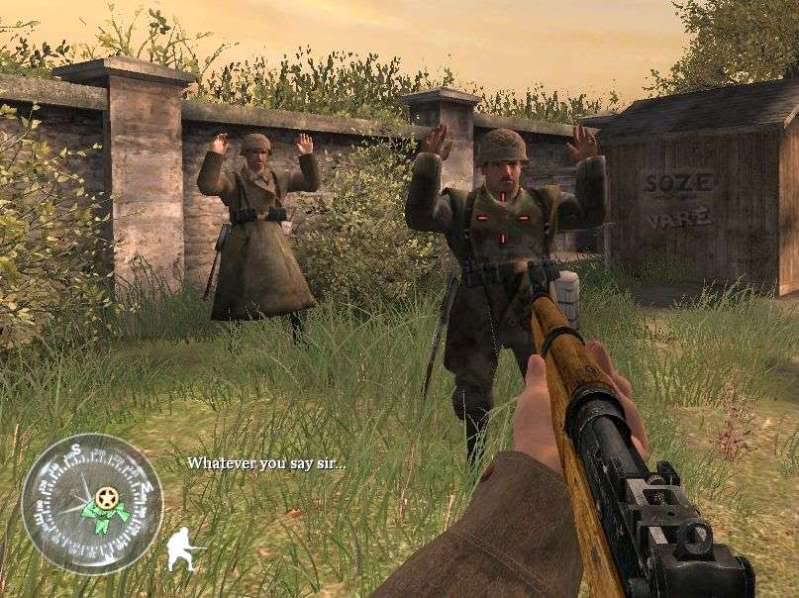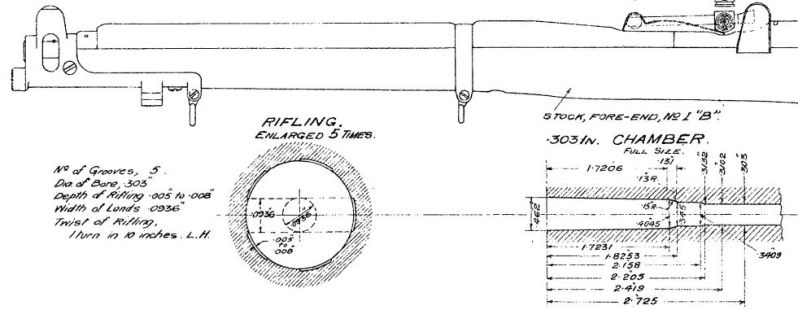-
Banned

-
06-20-2009 03:13 PM
# ADS
Friends and Sponsors

-
Legacy Member

Has anyone ever seen a fired .303 case with a shoulder that looks like this drawing?
-
-
Banned

"Depth of Rifling .005-.008", now thats 19th century quality control standards for you.
The old Krag rifles had bore diameters that varied to some extent, usually enough oversized that Bannerman was able to set Krag barrels back a few threads and rechamber them to .303 for the 1901 Springfield actioned training rifles he sent to the British
rifles had bore diameters that varied to some extent, usually enough oversized that Bannerman was able to set Krag barrels back a few threads and rechamber them to .303 for the 1901 Springfield actioned training rifles he sent to the British in 1915.
in 1915.
Such a wide spread of acceptable bore size is probably why some bores couldn't seal properly even with the card wad, and suffered severe erosion after relatively few rounds were fired.
I've seen bore diameters listed from .309 to .318 major dia being found on Enfield No.1 rifles. I doubt the AK varied that much, the pre WW2 Mosin Nagants did though.
Reynolds tells of experiments using bores of various dimeters and bullets of various diameters, all within the accepted tolerance range. He said that best accuracy was with the .312 bullets in the .310 bores. Guess thats another mystery solved as to why some Enfields are extremely accurate while others shoot Minute of man groups at fifty yards at best.
I looked up the acceptable "Figure Of Merit" for the .303 MkVII ammunition, its listed as 8 inches average at 600 yards, thats not that good at all. It at first appears to mean 2.5 MOA, but actually means no more than half the shots would hit within a 2.5 MOA grouping. Ranges beyond 600 were academic, they weren't expected to be able to hit a man sized target at that range. According to "Sniping in France " chances of making a headshot beyond 400 yards were so slim, even with a good scoped rifle, that even trying was considered an un necessary waste of the rifle's accurate bore life.
" chances of making a headshot beyond 400 yards were so slim, even with a good scoped rifle, that even trying was considered an un necessary waste of the rifle's accurate bore life.
I've been able to keep my groups sub MOA out to three hundred yards, using my taylored handloads, so lack of precision accuracy had to have been due to the quality of British MkVII ammunition.
The Canadians had little good to say for British ammunition. Apparently all Canadian manufactured .303 followed the original standards set for the round, while the British found their suppliers couldn't produce ammo within those standards. Ross rifles ended up being too close in tolerances to work well with the sub standard ammunition.
manufactured .303 followed the original standards set for the round, while the British found their suppliers couldn't produce ammo within those standards. Ross rifles ended up being too close in tolerances to work well with the sub standard ammunition.
Thanks to Ed we did finally figure out the inconsistencies in the quoted pressures for the various .303 military cartridges, that was of great help. Even a blind squirrel finds a nut now and then.
-
Legacy Member

Any one want to volunteer what the most accurate bullet is over a wide spectrum of #4 rifles?
I have Sierra and Speer .311 bullets.
Hornady and Remington .312 bullets
and a few might recognize the Speer .313 bullets
-
-
Advisory Panel


Ed's drawing v. CIP
Comparing the chamber dimensions in the drawing provided by Edward Horton with CIP chamber dimensions, I find a noticeable discrepancy.
Chamber MIN diameter values: (
CIP P1= base width = 11.74mm = 0.4622" / Ed= 0.462"
CIP P2 = start of shoulder = 10.25mm = 0.4035" / Ed = 0.4045"
CIP H1 = start of neck = 8.76mm = 0.3449" / Ed = 0.345"
CIP H2 = case mouth = 8.66mm = 0.3409" / Ed = 0.3409"
So far, so good. Near enough the same.
Chamber MIN length values:
R = headspace = 1.63mm = 0.064"
L1 = base (= bolt face with headspace R) to shoulder = 46.04mm = 1.812"
L1 -R = rim to shoulder = 1.749" / Ed = 1.7231"
L2 = base to start of neck = 48.06mm = 1.892"
L2-R = rim to neck = 1.828" / Ed = 1.8253"
L3 = base to case mouth = 56.44mm = 2.222"
(which is, incidentally, the exact value stamped on the chamber of my No1MkV, other Enfields I have seen have 2.22")
L3 - R = 2.158" / Ed = 2.158"
So there is a serious discrepancy in the length to the shoulder. A cartridge made with the cartridge (MAX) rim-shoulder length of 1.749" would be impossible to chamber in a chamber that only allows 1.7231".
And before someone points out that the sharp corners in the drawings do in fact have rounding radii that are also specified, I must mention that I know that, and the difference between start/end of the radius portion does not seem to be enough to cover the discrepancy. (L1 and L2 figures are taken to the intercept point of the straight lines).
I have presented these figures in the hope that one of you can compare the values with SAAMI and either point out my mistake or explain the discrepancy.
Patrick
Last edited by Patrick Chadwick; 06-21-2009 at 05:31 PM.
Reason: removed a surplus "a"
-
-
Advisory Panel


P.S. I've got it! It was a cunning trick by the wily Pattern Room to let Ed grab a deliberately erroneous drawing so that if the Yanks had the brass cheek to copy the 303 they at least wouldn't be able to use our ammo! An early example of disinformation? LOL.
OK Ed, the ball's in your court. Please pat it back gently!
Patrick
-
-
Legacy Member

>>>And before someone points out that the sharp corners in the drawings do in fact have rounding radii that are also specified, I must mention that I know that, and the difference between start/end of the radius portion does not seem to be enough to cover the discrepancy. (L1 and L2 figures are taken to the intercept point of the straight lines).<<<
Normal drawing practice usually states such a dimension is to the theoretically sharp corner. The sharp corner is easily found with an optical comparator.
My questions about both CIP and British pattern drawing would have to do with the following
pattern drawing would have to do with the following
What are the tolerances and for the British specification is it a minimum or maximum chamber?
What are the minimum and maximum cartridge drawing values.
Last edited by ireload2; 06-21-2009 at 06:43 PM.
-
-
Banned

Patrick Chadwick
I have been looking for over six years and have never found any military chamber drawings other than the S.A.I.D drawings that are part of the 1931 Instructions for armourers.
Most of my Enfield information came from Tom Ready in Lancashire U.K. who had access to the old MOD Pattern Room Library before it was sold off and from collector friends of his who also collected information on the Enfield Rifle .
.
The EGB Reynolds book that Badger has for download came from Tom Ready and Tom got it from a Dutch Enfield collector.
-
Banned

Hatchers note book gives the standard minimum headspace of a .303 chambered rifle as .064 and maximum as .068. I expect this was the industry standard for sporting rifles rather than the British military specs of the time.
military specs of the time.
Every increase in head gap clearance results in a looser fit of the tapered case body and shoulder in the chamber, even if the chamber were cut to minimum specs. Loose headspace would allow clearance for out of spec casings larger in diameter at some points than would allow them to fit easily in the same chamber with tighter headspace.
If they allowed as much as six thousandths difference in bore diameters as acceptable, how much variation would be considered acceptable in chamber dimensions?
I have read, long long ago, that military geology was taken into account when headspace measurements were agreed on. The size of grains of sand were measured. The figures given in that work were .004 for the US Soth West, .006 for European Beach sands and grit, and .009 for North African sand. I've only seen this quoted once, and couldn't tell you where, other than it was a reference work on the Krag Rifle.
Rifle.
I looked up the figures awhile back and they pretty much match what I remember, with the exception of US Western Mountain sands measuring .006 due to blue quartz content.
Military geology was not a separate discipline in the US military till WW2 but had been a part of British military planning at least as early as the 19th century. Everything from the average size of grains of sand to how sticky mud would be in one place compared to another.
The Ross Rifle debates give Krag headspace as .002, but the other reference work I mentioned stated that group sizes measured at each head clearance showed that the Krag gave tighter groups at .004 and that groups widened at .002. The officers doing the tests ( probably at Springfield ) recommended clearances no tighter than .004 and no looser than .006 for best accuracy.
It could be Ross meant that Krag Head Clearance was held to a tolerance of .002, the difference between .004 and .006.
If the chamber is not chromelined ( and none were back then)any coarse sand grains that get between cartridge case and chamber wall will usually embed in the steel of the chamber wall under chamber pressure ,locking the case in the chamber and making extraction difficult or impossible. A steeply tapered case might well help in breaking the grip of grit in the chamber.
-
I still think someone changed the chamber dimensions when the No. 4 was adopted. At least that's what my rifles "tell" me.
-




















 Register To Reply
Register To Reply










